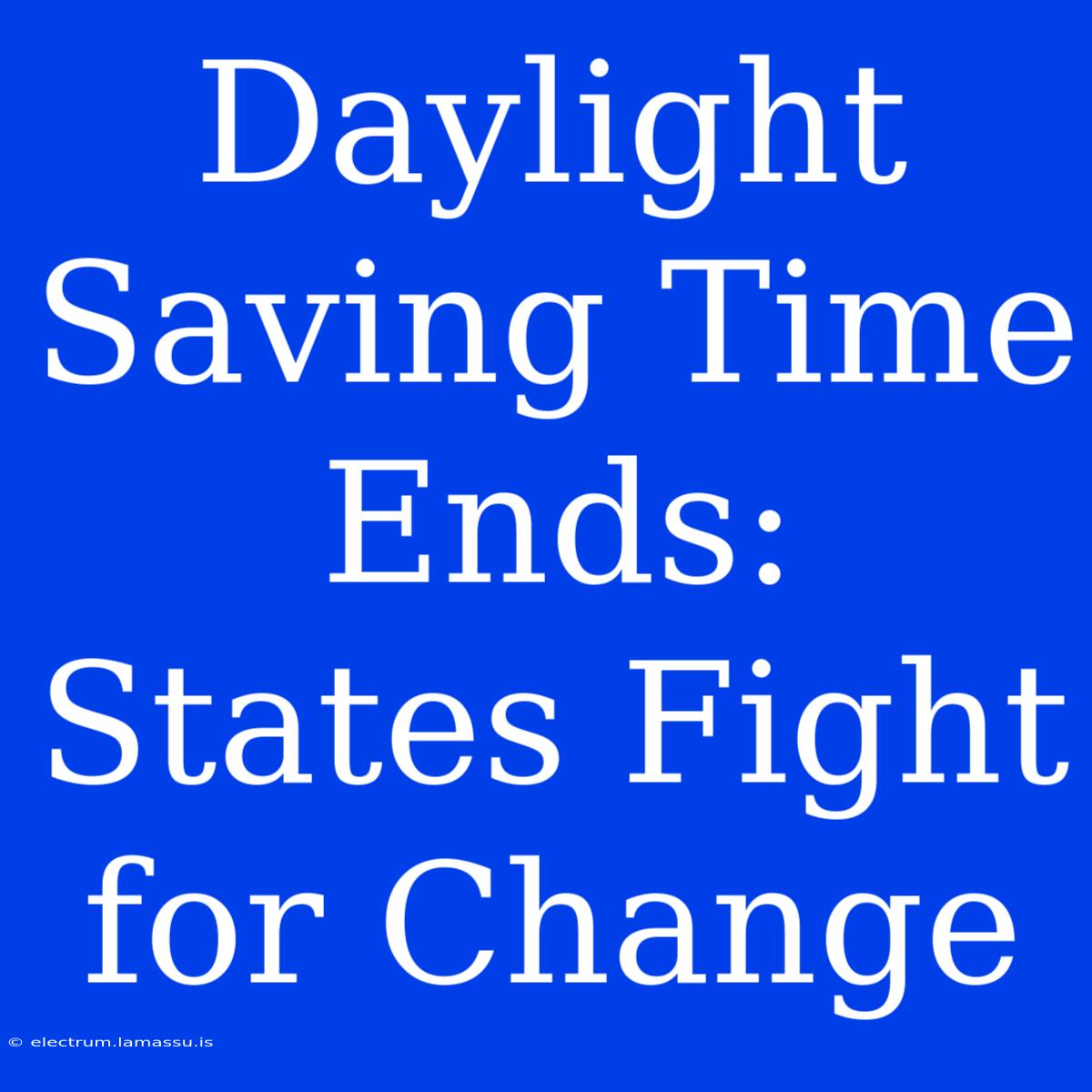Daylight Saving Time Ends: States Fight for Change
Is Daylight Saving Time a boon or a burden? The debate continues as states across the country push for permanent changes to the seasonal time switch.
Editor Note: As Daylight Saving Time comes to an end, the fight for permanent changes to the clock-shifting system is gaining momentum.
Why is this important? The potential health, safety, and economic implications of Daylight Saving Time (DST) are driving growing interest in ending the biannual clock adjustments. This article explores the arguments for and against DST, examining the movement for permanent standard time and its potential consequences.
Analysis: This article delves into the complexities surrounding DST, including:
- The history and origins of DST.
- The arguments for and against DST.
- State-level initiatives to abolish or permanently adopt DST.
- The potential impact on various sectors, including health, safety, and the economy.
Key Takeaways
| Key Takeaway | Description |
|---|---|
| DST's Origins and Purpose | Developed during World War I to conserve energy, later revived for its economic benefits. |
| Health and Safety Concerns | Studies suggest potential connections between DST and health risks, including sleep disorders, heart attacks, and workplace accidents. |
| Economic Impact | Debate exists regarding the economic benefits and drawbacks of DST, particularly for businesses operating across time zones. |
| State-Level Efforts for Change | Several states have passed legislation to abolish or permanently adopt DST, although legal challenges and federal regulations remain. |
| Potential for National Policy | Federal legislation to permanently standardize time is being considered, potentially resolving the patchwork of state laws. |
The Case for Change
The Debate Over DST
The arguments for and against Daylight Saving Time can be categorized into several key aspects:
Health Impacts
- Sleep Disruption: DST disrupts natural circadian rhythms, leading to sleep deprivation and an increased risk of sleep disorders.
- Facets:
- Role: The shift in sleep patterns impacts sleep quality and duration, potentially affecting mood, alertness, and cognitive function.
- Examples: Studies have shown higher rates of sleep disorders, including insomnia and circadian rhythm disorders, during the transition periods.
- Risks and Mitigations: While adjusting to DST takes time, minimizing exposure to light in the evenings and maintaining a consistent sleep schedule can help mitigate some of the negative impacts.
- Impacts and Implications: Long-term sleep disruption may contribute to chronic health issues such as cardiovascular disease, obesity, and mental health problems.
- Facets:
- Heart Health: Some studies suggest a possible link between DST and an increase in heart attacks, possibly due to sleep disruption and stress.
- Facets:
- Role: Shifting the biological clock can disrupt hormonal balance and affect heart function, potentially increasing the risk of cardiovascular events.
- Examples: Research has shown a slight increase in the incidence of heart attacks during the week following the spring transition to DST.
- Risks and Mitigations: Maintaining a healthy lifestyle, managing stress, and consulting with a doctor about any concerns are crucial for mitigating heart health risks.
- Impacts and Implications: Understanding the potential link between DST and heart health can inform public health initiatives and individual decisions regarding managing cardiovascular risk factors.
- Facets:
Safety Implications
- Road Safety: DST has been linked to an increase in car accidents, possibly due to sleep deprivation and decreased alertness during the early morning hours.
- Facets:
- Role: The change in daylight hours can affect visibility and driver alertness, potentially increasing the risk of crashes.
- Examples: Some studies have observed higher rates of traffic accidents during the first few days after the spring transition to DST.
- Risks and Mitigations: Driving safely, being aware of fatigue, and taking breaks during long journeys can help mitigate safety risks.
- Impacts and Implications: These findings highlight the importance of driver awareness, particularly during the transition periods of DST.
- Facets:
Economic Impact
- Energy Consumption: Proponents of DST argue that it reduces energy consumption by extending daylight hours and minimizing reliance on artificial lighting.
- Facets:
- Role: DST shifts daylight hours towards the evening, potentially reducing energy consumption for lighting and heating in homes and businesses.
- Examples: Studies have shown a small decrease in energy consumption during DST, primarily due to reduced lighting usage.
- Risks and Mitigations: The energy savings may vary depending on geographic location, climate conditions, and energy efficiency measures.
- Impacts and Implications: While energy savings from DST are debated, the broader impact on energy consumption and sustainability needs consideration.
- Facets:
State Initiatives for Change
- The Movement for Permanent Standard Time (PST): Many states, particularly in the western and northern parts of the country, have passed legislation to abolish DST or move to permanent standard time.
- Facets:
- Role: States are seeking to eliminate the biannual time changes and align their time zones with natural daylight patterns.
- Examples: Arizona, Hawaii, and several other states have already adopted permanent standard time, citing its benefits for health, safety, and economic stability.
- Risks and Mitigations: Legal challenges and federal regulations pose obstacles to state-level initiatives to permanently abolish DST.
- Impacts and Implications: These initiatives signal a growing public demand for a more standardized time system, potentially leading to national-level policy changes.
- Facets:
The Future of Time
The debate surrounding Daylight Saving Time continues, with potential health, safety, and economic implications fueling the movement for permanent change. While state-level initiatives have gained momentum, the future of DST ultimately rests on federal policy decisions. Whether the country moves toward permanent standard time or maintains the current system remains to be seen, but the ongoing debate highlights the need for a balanced approach to time that prioritizes health, safety, and economic considerations.

